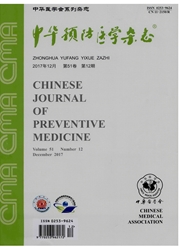

 中文摘要:
中文摘要:
目的了解2006--2010年山东省恙虫病的流行特征。方法以2006--2010年山东省疾病报告信息系统中收集的恙虫病患者为研究对象,共1291例。描述恙虫病的人口分布特征,基于地理信息系统(ArcGIS9.3)软件、空间聚集分析软件(SaTScan7.0),运用空间专题制图、距离倒数插值、空间自相关分析、空间聚集分析、时间聚集分析及时间趋势下空间变异分析,探讨该病的时空分布特征。,结果1291例患者的发病年龄分布为1~92岁,患者多为55岁以上,占49.5%(639/1291);男性占49.6%(640/1291),女性占50.4%(651/1291),男女比为1:1.02;农民、工人、学生及学龄前儿童均有发病,以农民为主,占84.8%(1095/1291)。全局Moran’s,指数值为0.324(P〈0.01)。8处地点该病发病率的局部Moran’s,指数值有统计学意义(P〈0.01),均为“高-高”(H—H)聚集,其中较为重要的地区为钢城、莱城、新泰、东港,发病数分别为38、154、160、105例,局部Moran’s,值分别为2.111、1.642、1.277、0.775。各年发病聚集时间分别为:2006年9月23日至11月20日(202例)、2007年10月2日至11月11日(197例)、2008年9月30日至11月7日(302例)、2009年9月25日至11月10日(204例)、2010年10月5日至11月13日(226例),RR值分别为45.55、34.60、50.64、53.09、79.84(P值均〈0.01)。共发现以泰安新泰为中心的辐射半径为58.28km,及以日照东港为中心的辐射半径22.68km的两处恙虫病聚集区,病例数分别为542、134例,RR分别为4.52、3.96(P值均〈0.01),地貌分别为内陆低山丘陵和沿海丘陵;以临沂蒙阴县为中心的辐射半径为45.82km的区域,恙虫病年增长率最高,达45.04%,RR=3.68(P〈0.01)。结论山东省恙虫病以中老年农民为主,9月下旬至11月上句为流行高峰;该病存在?
 英文摘要:
英文摘要:
Objective To explore the epidemic features of scrub typhus between year 2006 and 2010 in Shandong province. Methods Based on the data collected through Diseases Reporting Information System between year 2006 and 2010 in Shandong province, 1291 cases of scrub typhus patients were selected. The study described the population distribution features of the scrub typhus patients, and explored the temporal and spatial distribution features of the disease by applying the methods of spatial thematic mapping, inverse distance weighted, spatial autocorrelation analysis, spatial clustering analysis, temporal clustering analysis and spatial variation analysis in temporal trends based on Geographic Information software ( AreGIS 9. 3 ) and Spatial Clustering Software (SatScan 7.0). Results The onset age of the 1291 patients ranged between 1 and 92 years old. 639 out of 1291 patients were over 55 years old, accounting for 49.5%. A total of 640 patients were male and the other 651 patients were female, occupying 49.6% and 50.4% respectively. The gender ratio was 1:1.02 . Patients were found in farmers, workers, students and preschool children. However, most of the cases were farmers, up to 84.8% ( 1095/1291 ). Global Moran's I index was 0. 324 ( P 〈 0. 01 ). The local Moran's 1 index in 8 locations were proved to have statistical significance ( P 〈0.01 ), all of which were H-H clustering areas. Gangcheng (38 cases), Laicheng ( 154 cases), Xintai ( 160 cases) and Donggang (105 cases) were important locations, whose local Moran's I index were 2. 111, 1. 642, 1. 277 and 0. 775 respectively. The clustering period of scrub typhus in respective year were as follows: 2006.09.23 -2006. 11.20 (202 cases), 2007.10.02 -2007.11.11 (197 cases), 2008.09.30- 2008. 11.07 (302 cases), 2009. 09. 25 -2009. 11.10 (204 cases) , and 2010. I0. 05 -2010. 11.13 (226 cases), whose RR values were separately 45.5:5, 34. 60, 50. 64, 53.09 and 79.84 (P 〈 0. 01 ). Two spatial cluster
 同期刊论文项目
同期刊论文项目
 同项目期刊论文
同项目期刊论文
 期刊信息
期刊信息
